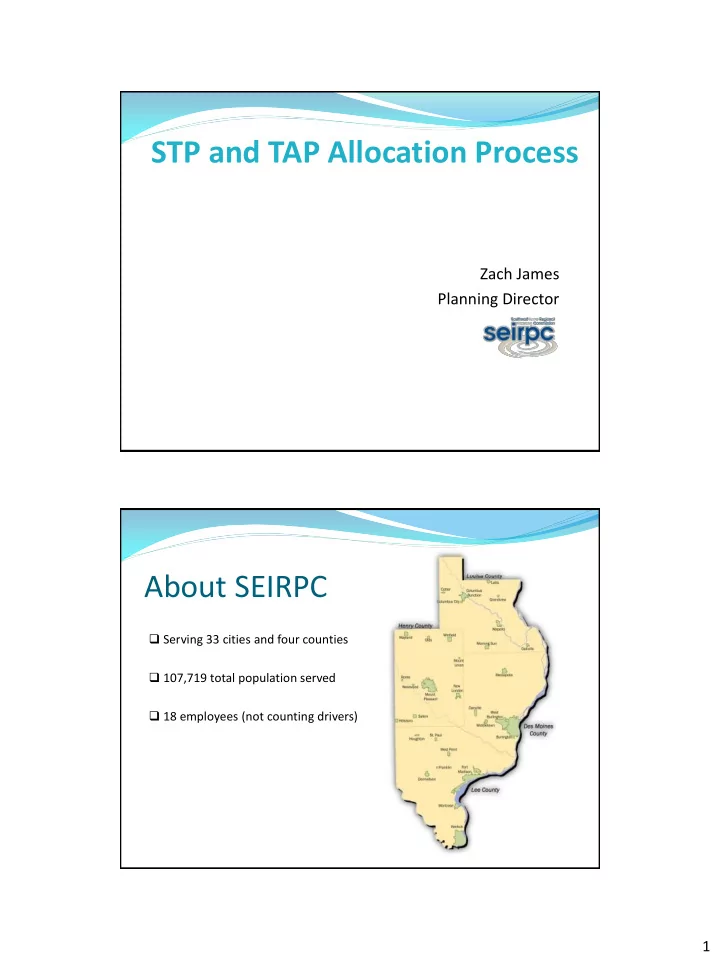

STP and TAP Allocation Process Zach James Planning Director About SEIRPC Serving 33 cities and four counties 107,719 total population served 18 employees (not counting drivers) 1
About SEIRPC 19 member board 63% elected officials Appointments from County Board of Supervisor and City Council of two largest cities in each county These three representatives appoint a private sector representation Education and workforce representatives from colleges and Iowa Workforce Development Iowa DOT Regional Planning Structure RPAs and MPOS are responsible for developing LRTP, TIP, TPWP, PPP, PTP with oversight from Iowa DOT/FHWA Regional boards are tasked with coordination of local consultation efforts to fulfill requirements RPAs and MPOs program and administer a portion of Iowa’s STP and TAP funding Regions determine own application and funding allocation structure Suballocation vs. competitive vs. combination vs. others? 2
SEIRPC Application and Funding Process Prior to 2005 ‘ Suballocation ’ Four counties and four largest cities in region each receive a set percentage of funding annually with or without a project Created a flexibility fund in 2004 for small cities Pros Local governments could plan ahead for funding and projects, funding levels virtually assured Cons No incentive to develop ‘regionally significant’ projects, funding was not spent in timely manner, smaller cities did not have equal access to funding Projects were reviewed by 9-member Technical Committee Consisted of county engineers and public works officials All members were also applicants or potential applicants Prompting Change In 2003, through the leadership of SEIRPC Board Chairman and Executive Director decided to review the process • SEIRPC Board formed a Transportation Subcommittee to evaluate the STP and ENH (TAP) allocation process • “Tail wagging the dog” - Funding is intended for the region, but was being controlled by engineers and public works officials • Documentation from 2003 FHWA Review – Access for small cities and large fund balances • Diminishing present dollar value of large STP balances – Buying power • STP funds as a regional development tool 3
Transportation Subcommittee Their purpose was to study the STP and ENH funding process and recommend changes if needed 7 Members were to be from both Policy Board and private sector Private Sector Don Carmody: Current Iowa DOT Commissioner Dan Wiedemeier: Former Iowa DOT Commissioner Dennis Hinkle: VP, Grow Greater Burlington SEIRPC Policy Board Jim Howell: Louisa County Supervisor Joe Kowzan: Mayor of Fort Madison (Chair) Dr. David Miller: Des Moines County Supervisor Brent Schleisman: Mount Pleasant Administrator (Vice Chair) Transportation Subcommittee First meeting in April 2003 with a recommendation in January 2004 after evaluating Region 16 sub allocation process Existing R egion 16 STP and ENH funded project history Other funding processes from MPOs and RPAs from Iowa and across the country Initial recommendation was considered by Board, but Subcommittee was asked to further refine recommendation Presented final recommendation in November 2014 after further review and scenario analysis 4
Transportation Subcommittee Recommendation Split STP Funds Into Two Pools (City 45%, County 55%) Expire Flexibility Fund Prioritize Projects through point system Transition of Technical Advisory Committee Recommendation to the Policy Board was unanimous Important due to County Supervisor on the fence about benefits of the recommended process Saw the opportunity for larger regional project for his county Recommendations approved December 2004 by Policy Board Current Application Process and Funding Allocation Cities and counties compete separately for available funding (Counties 55%, Cities 45%) STP applications are scored through subjective and objective criteria based upon planning factors (Economic Development, Safety, System Preservation, Mobility, Integration and connectivity, Local and Regional Factors) STP and TAP applications are scored by a committee composed of diverse regional representation with the committee making funding recommendations based on scoring SEIRPC Board of Directors responsible for final funding decisions in TIP 5
Current Application Process and Funding Allocation Technical Advisory Committee Structure - Two members from each county serve 3 year terms • One Public Works Official • One County Engineer • Two Business Professionals • One Agricultural Professional • One City Under 5,000 • One Economic Development Professional • One SEIRPC Board Member • One At-Large Member (Chosen by SEIRPC Board) Lessons Learned Board leadership and support was crucial in initiating the process, as well as buying in to the recommended changes Encouraged larger scale projects on city site US Highway 61 Interchange Former Highway 34 through Mount Pleasant Former Highway 61 through Fort Madison While difficult, small cities can compete Mediapolis, West Point, and New London have been successful Keeps balances down (although current policy promotes some carryover) Scoring criteria is evolving Can’t change the county engineers – No competition 6
Questions Zach James SEIRPC Planning Director Phone: 319.753.4313 zjames@seirpc.com www.seirpc.com 7
Recommend
More recommend